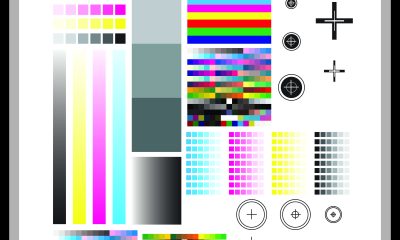Signs and screen printing are like two kids from the same colorful, wacky family. Although they have the same parents (communication and commerce), one is way bigger, older, and more mature, if you can call getting draped around the exterior of a high-rise building 100 feet in the air “mature.” The sibling, “silk screening,” is younger and more adventurous, with interests in consumer electronics, T-shirts, and decorative arts, to name but a few growing segments. Both are practiced by few, yet found everywhere, on everything, in everything.
Signs and screen printing are like two kids from the same colorful, wacky family. Although they have the same parents (communication and commerce), one is way bigger, older, and more mature, if you can call getting draped around the exterior of a high-rise building 100 feet in the air “mature.” The sibling, “silk screening,” is younger and more adventurous, with interests in consumer electronics, T-shirts, and decorative arts, to name but a few growing segments. Both are practiced by few, yet found everywhere, on everything, in everything.
The men and women who work in sign and screen-printing companies know they are a big part of the visual fabric of our modern civilization, even though most people take all the graphics, signage, and functional printing for granted. Every two-bit college has art and design courses, but very few are training workers specifically for our industry. It doesn’t seem to be high on anyone’s list as a career path. That’s sad, because we offer one the most creative, challenging, and interesting work environments. What we do is important too, and not just for communicating a discount sale at the corner store. We insiders know the truth: Remove signs and screen printing from the modern world and it comes to a screeching, crashing halt.
Imagine a world without signs and screen printing:
Roadways, cities and buildings with no wayfinding signage? What a mess that would be. “But you could still use your cell phone,” you might be thinking. No, you can’t—it’s made using screen printing too! “OK, no worries, I’ll just get in the car. Wait—where are the instruments and controls?!” You freak out and crash.
Advertisement
A white van shows up at the crash scene. It’s an EMS ambulance, but nobody can tell without the markings on the outside of the vehicle. Then a massive traffic jam forms because there are no road signs and the traffic lights don’t work because the printed circuits controlling everything are gone. The paramedics jump out of the van, dressed all in white too, with no logos or identifiers. They see that your heart has stopped and spring into rescue mode. But damn, the defibrillator doesn’t work—the contact pads were screen printed and the control panels, too.
That’s the world without signs or screen printing. It may not make a good Hollywood disaster flick, but it would be as bad in its own way as an asteroid strike or a massive power failure wiping out the trappings of modern life.
Don’t get me wrong—I don’t see a dystopian future for us. Both industries are in good shape, with most companies experiencing growth. With the arrival of digital printing and breakthrough technologies in all aspects of signage, we’ve come a long way from some guy with a brush and a can of 1-Shot. LED lighting is allowing for lower operating costs and power savings in both illuminated signs and screen-exposure systems. The futuristic outdoor advertising seen in 1982’s film “Blade Runner” is now commonplace. And screen printing, that simplistic process invented by some sign writers in San Francisco who were looking for a way to make mass quantities of showcards on the cheap, continues to reinvent itself as it creates products as diverse as solar cells, touch screens, and road signage printed with light-absorbing material that allows the message to light up at night.
So let’s imagine where we might be in 20 years. That’s how long wide-format digital printers have been in the sign industry, and the time it took for smartphones to replace landlines. It doesn’t seem that long ago, but both were revolutionary changes for sure, and they impact everything. Where are our next breakthrough technologies?
• Self-powering garments make sense. Build solar receptors into the clothes we wear so we can power our electronic devices on the go. The same technology allows for larger, self-powered signs that illuminate at night without plugging into anything. Done right, signs may become net power producers, generating excess power for other uses, or channeled back into the grid.
• Other new screen-printed energy sources are coming, including hydrogen and other fuel cells. Carbon batteries on recyclable materials are already in development, and it seems clear to everyone but the oil industry that solar power is the future. Screen printing will be there, and it may solve the problems associated with solar energy when night falls or the clouds roll in.
Advertisement
• Hand lettering and hand-sculpted signs will continue to grow in popularity as a backlash to computer-generated “flat” signage. I can also imagine a trend in architecture where signage becomes part of the building itself. After all, companies are obsessed with branding and the audience they want to attract doesn’t seem to appreciate the written word anymore. Maybe we’ll see more buildings acting as their own signs.
Readers, what do you think? Where do you think signage and printing will go in the next few decades?

 Art, Ad, or Alchemy1 month ago
Art, Ad, or Alchemy1 month ago
 Case Studies1 month ago
Case Studies1 month ago
 Andy MacDougall1 month ago
Andy MacDougall1 month ago
 Columns2 weeks ago
Columns2 weeks ago
 Editor's Note2 weeks ago
Editor's Note2 weeks ago
 Thomas Trimingham2 months ago
Thomas Trimingham2 months ago
 Marshall Atkinson2 weeks ago
Marshall Atkinson2 weeks ago
 News & Trends1 month ago
News & Trends1 month ago















